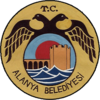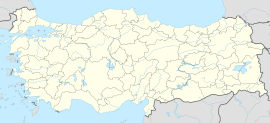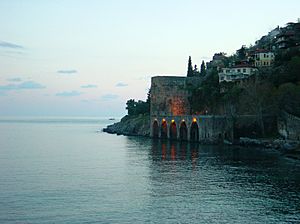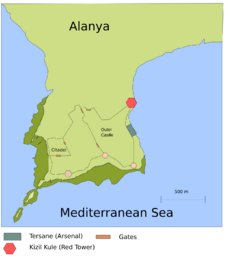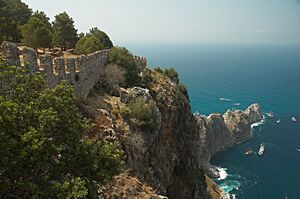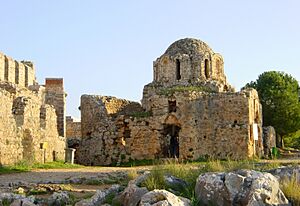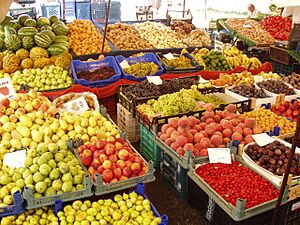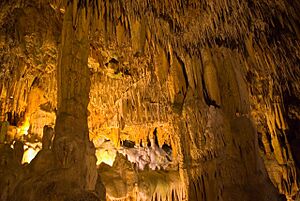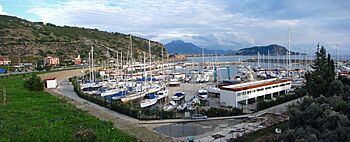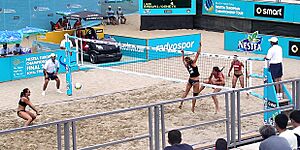Alanya facts for kids
Quick facts for kids
Alanya
|
|||
|---|---|---|---|
|
Settlement
|
|||
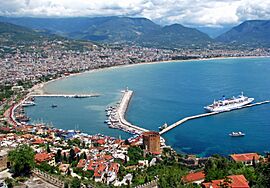
Castle and harbour of Alanya
|
|||
|
|||
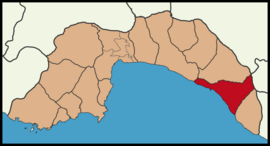
Map showing Alanya District in Antalya Province
|
|||
| Country | Turkey | ||
| Province | Antalya | ||
| Area | 1,577 km2 (609 sq mi) | ||
| Population
(2022)
|
364,180 | ||
| • Density | 230.93/km2 (598.11/sq mi) | ||
| Time zone | TRT (UTC+3) | ||
| Postal code |
07400
|
||
| Area code | 0242 | ||
Alanya (pronounced ah-LAHN-yah), once called Alaiye, is a lively beach city and district in Antalya Province, Turkey. It sits on Turkey's southern coast, in the Mediterranean area, about 133 kilometers (83 miles) east of Antalya. The whole district covers 1,577 square kilometers (609 square miles) and had a population of 364,180 people in 2022. The city itself is home to 189,222 residents.
Alanya is built on a small peninsula that juts into the Mediterranean Sea, with the Taurus Mountains rising behind it. This special location made it an important place for many powerful empires throughout history. These included the Romans, Byzantines, and Ottomans. Alanya became most important during the Middle Ages under the Seljuk Sultanate of Rûm. Sultan Alaeddin Kayqubad I gave the city its name, Alaiye, which later became Alanya. He built many famous landmarks, like the Kızıl Kule (Red Tower), the Tersane (Shipyard), and Alanya Castle.
Thanks to its sunny Mediterranean climate, beautiful nature, and rich history, Alanya is a very popular place for tourists. Tourism makes up a big part of Turkey's tourism industry. Since 1958, tourism has grown to be the city's main business, causing its population to grow a lot too. Alanya also hosts fun sports events and cultural festivals every year. In 2024, Osman Tarık Özçelik became the new Mayor of Alanya.
Contents
- Exploring Alanya's Past: How the City Got Its Name
- A Journey Through Alanya's History
- Alanya's Geography and Climate
- Must-See Sights in Alanya
- Alanya's Growing Population
- Alanya's Culture and Festivals
- Alanya's Economy
- Media and Communication
- Getting Around Alanya
- Sports in Alanya
- Alanya's Neighbourhoods
- Alanya's International Connections
- Famous People from Alanya
- See also
Exploring Alanya's Past: How the City Got Its Name
Alanya has had many names over the centuries as different groups took control. In ancient Latin, it was called Coracesium. In Greek, it was Korakesion, which came from the Luwian word Korakassa, meaning "pointy city" or "protruding city."
Later, during the Byzantine Empire, it was known as Kalonoros or Kalon Oros. This means "beautiful mountain" in Greek. When the Seljuks took over, they renamed it Alaiye. This name came from their Sultan, Alaeddin Kayqubad I.
In the 13th and 14th centuries, Italian traders called the city Candelore or Cardelloro. The name finally became Alanya in 1935. This happened when Mustafa Kemal Atatürk, the founder of modern Turkey, visited. The story says the change happened because of a misspelled telegram in 1933.
A Journey Through Alanya's History

People have lived in the Alanya area for a very long time. Tools found in the nearby Karain Cave show that people lived there as far back as 20,000 BC. Archeologists have also found proof of a port at Syedra, south of Alanya, around 3,000 BC.
A Phoenician language tablet from 625 BC was found in the area. The city is also mentioned in a Greek geography book from the 4th century BC. The castle rock was likely used by the Hittites and the Achaemenid Empire. It was first fortified during the Hellenistic period after Alexander the Great conquered the area.
After Alexander's death, the region went to Ptolemy I Soter. His family kept some control over the local people. The port became a safe place for pirates in the Mediterranean Sea. The city even supported the pirate Diodotus Tryphon when he became king for a short time.
The Roman Republic fought these pirates. Finally, in 67 BC, Pompey ended the piracy. He made Alanya part of the Pamphylia province. The famous Battle of Korakesion was fought right in Alanya's harbor. Even after the Romans took over, local tribes sometimes caused trouble.
Alanya in the Middle Ages
As Christianity spread, Alanya became a place where a bishop lived. Its bishops attended important church meetings. Islam arrived in the 7th century with Arab raids. This led to new forts being built.
The area fell under the control of Seljuk Turks after a big battle in 1071. But the Byzantines took it back in 1120. Later, the Christian Armenian Kingdom of Cilicia sometimes held the port.
In 1221, the Seljuk Sultan Alaeddin Kayqubad I captured the city. He married the daughter of the previous ruler. Under Seljuk rule, Alanya had its "golden age." It became like a winter capital for their empire.
Sultan Kayqubad I started many building projects. He built the twin citadel, city walls, an arsenal, and the Kızıl Kule (Red Tower). These made Alanya an important seaport for trade across the western Mediterranean. He also built beautiful gardens and pavilions outside the city walls. Many of his buildings can still be seen today.
After a big battle in 1243, the Mongols weakened the Seljuk empire. Alanya then faced many invasions from other Turkish groups. In 1471, General Gedik Ahmed Pasha brought Alanya into the growing Ottoman Empire. The Ottomans made it a local capital. They also took control of the important lumber trade.
Over time, new sea routes around Africa made Alanya's port less important. In 1571, the Ottomans made the city part of the new province of Cyprus. This further reduced its trade importance.
In the 18th and 19th centuries, many beautiful villas were built in Alanya. After World War I, Alanya was briefly given to Italy. But in 1923, it became part of the new Turkish Republic. Many Christians living in Alanya moved to Greece during this time.
Tourism started to grow in the 1960s. People came to Alanya to visit Damlataş Cave, which was believed to have healing properties. When Antalya Airport opened in 1998, it became much easier for international tourists to visit. This helped Alanya become the popular resort it is today. The city's population has grown quickly, leading to many new buildings and modern improvements.
Alanya's Geography and Climate
Alanya is located on the Gulf of Antalya, on the flat coastal land of Pamphylia. It sits between the Taurus Mountains to the north and the Mediterranean Sea to the south. This area is part of the Turkish Riviera, with about 70 kilometers (43 miles) of coastline.
The Dim River flows from the mountains east of the city. It winds its way southwest into the Mediterranean Sea. The land between the sea and the mountains has special forests with Lebanon Cedar trees and other plants.
The city is split into two parts by a rocky peninsula. This peninsula is a key feature of Alanya. On the east side of the peninsula are the harbor, the city center, and Keykubat Beach. Keykubat Beach is named after Sultan Kayqubad I. On the west side, you'll find Damlataş Beach and Kleopatra Beach. Damlataş Beach is named after the famous "dripping caves." The name "Cleopatra" for the other beach might come from the Egyptian queen's visit or because it was part of her wedding gift to Mark Antony.
Atatürk Bulvarı is the main road that runs along the sea. It separates the southern, more touristy part of Alanya from the northern, more local side that goes up into the mountains.
Weather in Alanya
Alanya has a typical hot-summer Mediterranean climate. This means it has long, hot, and dry summers. The subtropical high pressure zone brings most of the rain during the winter. This is why Alanya's tourism board uses the slogan "where the sun smiles."
Winters are mild and wet. Sometimes, storms bring waterspouts close to the shore. The Taurus Mountains are very close to the sea. This can cause fog and even rainbows on many mornings. The tall mountains also create an interesting sight: you can often see snow on them even on warm days in the city below. The sea around Alanya has an average temperature of 21.4°C (70.5°F) each year.
| Climate data for Alanya (1991-2020, extremes 1970-present) | |||||||||||||
|---|---|---|---|---|---|---|---|---|---|---|---|---|---|
| Month | Jan | Feb | Mar | Apr | May | Jun | Jul | Aug | Sep | Oct | Nov | Dec | Year |
| Record high °C (°F) | 23.2 (73.8) |
25.0 (77.0) |
28.1 (82.6) |
32.5 (90.5) |
36.0 (96.8) |
38.8 (101.8) |
43.7 (110.7) |
41.6 (106.9) |
38.2 (100.8) |
35.9 (96.6) |
31.5 (88.7) |
24.7 (76.5) |
43.7 (110.7) |
| Mean daily maximum °C (°F) | 16.5 (61.7) |
17.0 (62.6) |
19.1 (66.4) |
21.8 (71.2) |
25.7 (78.3) |
29.7 (85.5) |
32.7 (90.9) |
33.4 (92.1) |
31.3 (88.3) |
27.4 (81.3) |
22.4 (72.3) |
18.1 (64.6) |
24.6 (76.3) |
| Daily mean °C (°F) | 12.4 (54.3) |
12.8 (55.0) |
14.9 (58.8) |
17.8 (64.0) |
21.8 (71.2) |
25.9 (78.6) |
28.9 (84.0) |
29.5 (85.1) |
27.1 (80.8) |
22.9 (73.2) |
17.9 (64.2) |
14.1 (57.4) |
20.5 (68.9) |
| Mean daily minimum °C (°F) | 9.5 (49.1) |
9.6 (49.3) |
11.5 (52.7) |
14.4 (57.9) |
18.5 (65.3) |
22.4 (72.3) |
25.4 (77.7) |
26.1 (79.0) |
23.4 (74.1) |
19.3 (66.7) |
14.6 (58.3) |
11.2 (52.2) |
17.2 (62.9) |
| Record low °C (°F) | −1.9 (28.6) |
−2.2 (28.0) |
0.9 (33.6) |
4.0 (39.2) |
9.8 (49.6) |
13.3 (55.9) |
16.9 (62.4) |
14.1 (57.4) |
13.2 (55.8) |
9.5 (49.1) |
2.9 (37.2) |
0.4 (32.7) |
−2.2 (28.0) |
| Average precipitation mm (inches) | 210.6 (8.29) |
137.3 (5.41) |
91.3 (3.59) |
68.8 (2.71) |
36.0 (1.42) |
9.2 (0.36) |
3.0 (0.12) |
2.7 (0.11) |
29.6 (1.17) |
100.6 (3.96) |
158.7 (6.25) |
251.2 (9.89) |
1,099 (43.28) |
| Average precipitation days (≥ 1.0 mm) | 11.7 | 9.2 | 6.9 | 5.9 | 3.1 | 1.8 | 1.5 | 1.3 | 2.6 | 5.1 | 7.2 | 10.9 | 67.2 |
| Average relative humidity (%) | 62.4 | 61 | 62.4 | 66.6 | 68.3 | 66.8 | 66.5 | 65.5 | 60.7 | 58.2 | 58.7 | 63.5 | 63.4 |
| Mean monthly sunshine hours | 127.1 | 127.1 | 192.2 | 219.0 | 288.3 | 348.0 | 325.5 | 316.2 | 273.0 | 220.1 | 159.0 | 133.3 | 2,728.8 |
| Mean daily sunshine hours | 4.1 | 4.5 | 6.2 | 7.3 | 9.3 | 11.6 | 10.5 | 10.2 | 9.1 | 7.1 | 5.3 | 4.3 | 7.5 |
| Source 1: NOAA, Turkish State Meteorological Service (extremes-sun) | |||||||||||||
| Source 2: Meteomanz(extremes since 2012)Weather2 | |||||||||||||
| Jan | Feb | Mar | Apr | May | Jun | Jul | Aug | Sep | Oct | Nov | Dec |
|---|---|---|---|---|---|---|---|---|---|---|---|
| 17.8 °C (64.0 °F) | 16.9 °C (62.4 °F) | 17.3 °C (63.1 °F) | 17.9 °C (64.2 °F) | 21.2 °C (70.2 °F) | 25.3 °C (77.5 °F) | 27.9 °C (82.2 °F) | 29.0 °C (84.2 °F) | 27.7 °C (81.9 °F) | 24.9 °C (76.8 °F) | 21.2 °C (70.2 °F) | 19.0 °C (66.2 °F) |
Must-See Sights in Alanya
One of Alanya's most famous landmarks is Alanya Castle, a huge fortress from the Seljuk era, built in 1226. Many important places in the city are found within or near the castle. The castle was built on top of older forts. It served as both a palace for local leaders and a strong defense against attacks.
Inside the castle, you can find the Süleymaniye mosque and a caravanserai (an old inn for travelers). The old city walls go around much of the eastern peninsula, and you can walk along them. Inside the walls are many historic villas, which are old houses that show the beautiful Ottoman architecture style. Most of these were built in the early 1800s.
The Kızıl Kule (Red Tower) is a 33-meter (108-foot) tall brick building at the harbor, below the castle. It holds the city's ethnographic museum, which displays local culture and history. Sultan Kayqubad I brought a famous architect from Syria to design this building. It was the last of Alanya Castle's 83 towers and was built to protect the shipyard. It's a great example of medieval military architecture.
The Tersane, or dockyard, is a medieval drydock built by the Seljuk Turks in 1221. It's 57 meters (187 feet) long and 40 meters (131 feet) wide. It has five arched sections where ships could be built or repaired. The Alara Castle and caravanserai, also built by Kayqubad, have been turned into a museum.
You can also visit Mustafa Kemal Atatürk's House and Museum. This house is kept as it was when Atatürk stayed there in 1935. It shows what a traditional Ottoman villa looked like inside, with items from the 1930s. The Alanya Museum, located near Damlataş Beach, has archaeology finds from the area. These include a large bronze Hercules statue and old Roman items.
Alanya is a member of the European Association of Historic Towns and Regions. In 2009, city officials asked UNESCO to make Alanya Castle and Tersane World Heritage Sites.
Alanya's Growing Population
| Year | District | City |
|---|---|---|
| 1893 | 37914 | |
| 1965 | 43459 | 12436 |
| 1970 | 53552 | 15011 |
| 1975 | 63235 | 18520 |
| 1980 | 74148 | 22190 |
| 1985 | 87080 | 28733 |
| 1990 | 129106 | 52460 |
| 1997 | 235884 | 117311 |
| 2007 | 226236 | 91713 |
| 2012 | 264692 | 104573 |
| 2017 | 299464 | - |
| 2022 | 364180 | - |
Alanya's population has grown a lot. In 1985, the district had 87,080 people. By 2022, it had grown to 364,180. This big increase is mostly because many people have moved to the city. This is due to the growing real estate business.
In 2007, about 9,789 people living in Alanya were from Europe. Many of them were from Germany and Denmark. A total of 17,850 foreigners own property in Alanya. Many Iranians have also moved to the city. During the Persian New Year, many Iranians visit Alanya for vacation.
The number of tourists also makes the population much larger in the summer. About 1.1 million tourists visit Alanya each year. These visitors, both Turkish and European, help the local economy.
Many people have moved to Alanya from other parts of Turkey. There are also Yörük nomads who live in the Taurus Mountains north of the city during different seasons. In 2018, it was thought that about 300 Finns live in Alanya all year. Another 3,000 Finns stay there during the winter. In October 2022, statistics showed that 55,000 foreigners live in Alanya. More than half of them speak Russian.
| Foreigners in Alanya | ||
| 1 | 10,000 | |
| 2 | 3,821 | |
| 3 | 3,000 | |
| 4 | 769 | |
| 5 | 634 | |
| 6 | 521 | |
| 7 | 475 | |
| 8 | 383 | |
| 9 | 303 | |
| 10 | 297 | |
Most people in Alanya are Muslim. While there are many old churches in the area, they don't have weekly Christian services. In 2006, a German language Protestant church opened for seasonal services. This showed the growing number of Europeans in the city. In 2015, the city started fixing up the Greek Orthodox Agios Georgios Church. This church is now used for monthly Russian Orthodox services. Alanya also lets Christian groups use the Atatürk Cultural Center for bigger religious events.
Alanya's Culture and Festivals
Alanya's culture is part of the wider Culture of Turkey. The city's location by the sea is important for many yearly festivals. The Tourism and Arts Festival happens at the end of May or early June. It marks the start of the tourism season.
Another important event is the Alanya International Culture and Art Festival. This festival takes place in the last week of May and is a well-known Turkish festival. The Alanya Jazz Days have been held every September or October since 2002. These concerts take place at the Kızıl Kule and feature Turkish and international jazz musicians.
The Alanya Chamber Orchestra started in 2007. The International Alanya Stone Sculpture Symposium takes place in November. The Alanya Documentary Festival began in 2001. Famous Turkish poet and writer Onat Kutlar was born in Alanya, as was actress Sema Önür.
Alanya also celebrates Mustafa Kemal Atatürk's visit on February 18 each year. This celebration is held at Atatürk's House and Museum. The Alanya Museum shows off old items found in the city. European residents in Alanya often celebrate their own national holidays. The city even had a Christmas market in December 2010. Iranians also celebrate their New Year, Nevruz, in Alanya.
Alanya's Economy
Tourism is the main business in Alanya, bringing in over 1.1 billion euros each year. The area also has many fruit farms. They grow lots of lemons, oranges, tomatoes, bananas, and cucumbers. In 2006, about 80,000 tons of citrus fruits were grown. Farmers are now growing more greengage plums and avocados because citrus fruits are becoming less profitable.
Even though Alanya is by the sea, not many people work in fishing. In the 1970s, a special system was created to help protect fish stocks. This smart system was part of research by Elinor Ostrom, who later won the Nobel Prize in Economics.
Since 2003, it has become easier for people from other countries to buy land in Turkey. This has made the housing business in Alanya very successful. Many new homes and apartments are being built for people from Europe and Asia who live there part-time. Most of these buyers are individuals, not big investors. This building boom has caused property prices to go up.
Tourism in Alanya
The first modern motel in Alanya was built in 1958. This is seen as the start of the city's tourism industry. Hotels have been built quickly to welcome many tourists. As of 2007, Alanya had 157,000 hotel beds.
Damlataş Cave was the first big draw for tourists. People came because of the cave's special air, which is about 22°C (72°F) and 95% humid. The cave is on the west side of the peninsula, near Damlataş Beach. Many tourists, especially from Scandinavia, Germany, Russia, and the Netherlands, visit Alanya during the warmer months. They like the affordable property, warm weather, sandy beaches, and delicious food.
Other fun outdoor activities include wind surfing, parasailing, and banana boating. Alanya also has Sealanya, one of Europe's largest waterparks, and Turkey's biggest go-kart track. Some tourists also come for hunting wild goat, pig, and partridge in nature reserves.
Media and Communication
Alanya has 10 local daily newspapers. One of them is Yeni Alanya, which also has a magazine called Orange. This magazine is available in English, German, and Turkish. There are two German language newspapers for German-speaking residents and visitors: Aktuelle Türkei Rundschau and Alanya Bote. A monthly magazine called Hello Alanya is published for foreigners in English and Dutch. The free regional newspaper, Riviera News, is printed in English and can be found widely in Alanya.
Five radio stations broadcast from the city. Alanya FM Radyo and Radio Flash play popular music. Other stations, like Alanya RadyoTime, play Turkish music, news, and talk shows. Alanya also has two local television stations, Kanal Alanya and Alanya Televizyonu (ATV).
Getting Around Alanya
The D 400 Highway connects Alanya from the east and west. It goes around the city and through the center via Atatürk Bulvarı. The D695 highway runs north-south and connects to the D400 west of the city.
Antalya Airport is 121 kilometers (75 miles) away and has international flights. The new Antalya Gazipaşa Airport is much closer, only 14.5 kilometers (9 miles) from the city. It started having regular domestic flights in 2010 and international flights in 2011. There are no train routes to Alanya.
You can get around Alanya using buses and dolmuşes (shared taxis) from the city's two bus stations. However, buses usually stick to the main roads. Inside the city, people travel by car, taxi, or on foot, as many roads in the old town are closed to cars.
The harbor has places for cruise ships to dock. Seasonal ferries and hydrofoils also go to Kyrenia in Northern Cyprus. The number of cruise ships docking in Alanya grew by 50% in 2013. West of the city is the Alanya Marina, which opened in 2008 and was fully expanded by 2010. The city is also setting up a community bicycle program with 150 bicycles and twenty rental stations.
Sports in Alanya
Alanya is home to a women's basketball team, Alanya Belediye. The city also has a Süper Lig soccer team called Alanyaspor. The club was founded in 1948 and plays its home games at Milli Egemenlik Stadium. They were promoted to the top league in 2015–16. In 2007, the city started building a new soccer facility for winter competitions.
Alanya's location by the water makes it perfect for certain events. It is famous for its yearly triathlon, which has been held every October since 1990. Marathon swimming competitions have also been part of the triathlon since 1992. Alanya also hosted a modern pentathlon in 2009.
Alanya regularly hosts The Turkish Open, which is part of the European Beach Volleyball championship tour in May. In 2007, the Turkish Volleyball Federation convinced the European Volleyball Confederation to build a beach volleyball training center in Alanya.
The city also hosts national events, like the annual beach handball tournament. Alanya is usually the finish line for the seven-day Presidential Cycling Tour of Turkey. Other cycling events include the Alanya International Mountain Bike Race. In 2010, the European Cycling Union held its road cycling championship in Alanya.
Recently, Alanya also hosted the 22nd Alanya International Culture, Art, and Tourism Festival, the Alanya International Piano Competition and Festival, and the Europe Triathlon Cup Alanya, all in 2024.
Alanya's Neighbourhoods
There are 103 neighbourhoods in Alanya District:
- Akçatı
- Akdam
- Alacami
- Alara
- Aliefendi
- Asmaca
- Avsallar
- Bademağacı
- Basırlı
- Başköy
- Bayırköy
- Bayırkozağacı
- Bektaş
- Beldibi
- Beyreli
- Bıçakçı
- Bucakköy
- Burçaklar
- Büyükhasbahçe
- Büyükpınar
- Çakallar
- Çamlıca
- Çarşı
- Cikcilli
- Çıplaklı
- Cumhuriyet
- Değirmendere
- Demirtaş
- Dereköy
- Dinek
- Elikesik
- Emişbeleni
- Fakırcalı
- Fığla
- Gözübüyük
- Gözüküçüklü
- Güllerpınarı
- Gümüşgöze
- Gümüşkavak
- Güneyköy
- Güzelbağ
- Hacet
- Hacıkerimler
- Hacımehmetli
- Hisariçi
- Hocalar
- İmamlı
- İncekum
- İshaklı
- İspatlı
- Kadıpaşa
- Karakocalı
- Karamanlar
- Karapınar
- Kargıcak
- Kayabaşı
- Keşefli
- Kestel
- Kızılcaşehir
- Kızlarpınarı
- Kocaoğlanlı
- Konaklı
- Küçükhasbahçe
- Kuzyaka
- Mahmutlar
- Mahmutseydi
- Oba
- Obaalacami
- Okurcalar
- Orhanköy
- Ortakonuş
- Öteköy
- Özvadi
- Paşaköy
- Payallar
- Saburlar
- Sapadere
- Saray
- Şekerhane
- Seki
- Şıhlar
- Soğukpınar
- Sugözü
- Süleymanlar
- Taşbaşı
- Tepe
- Tırılar
- Tophane
- Toslak
- Tosmur
- Türkler
- Türktaş
- Uğrak
- Uğurlu
- Üzümlü
- Uzunöz
- Yalçı
- Yasırali
- Yaylakonak
- Yaylalı
- Yenice
- Yeniköy
- Yeşilöz
Alanya's International Connections
Alanya has special connections with many cities around the world. The most important connection is with Nea Ionia, a city in Greece. Many Christians from Alanya moved there in 1923 after a population exchange. Alanya is twinned with:
 Dergachyovsky District, Russia
Dergachyovsky District, Russia Fushun, China
Fushun, China Geoagiu, Romania
Geoagiu, Romania Gladbeck, Germany
Gladbeck, Germany Goa, India
Goa, India Keszthely, Hungary
Keszthely, Hungary Mahdia, Tunisia
Mahdia, Tunisia Ankara, Turkey
Ankara, Turkey Nea Ionia, Greece
Nea Ionia, Greece Murmansk, Russia
Murmansk, Russia Oer-Erkenschwick, Germany
Oer-Erkenschwick, Germany Rovaniemi, Finland
Rovaniemi, Finland Šilutė, Lithuania
Šilutė, Lithuania South-Eastern AO (Moscow), Russia
South-Eastern AO (Moscow), Russia Špindlerův Mlýn, Czech Republic
Špindlerův Mlýn, Czech Republic Talsi, Latvia
Talsi, Latvia Trakai, Lithuania
Trakai, Lithuania Wodzisław Śląski, Poland
Wodzisław Śląski, Poland Wronki, Poland
Wronki, Poland Zelenogorsk, Russia
Zelenogorsk, Russia Borås, Sweden
Borås, Sweden
Friendly cities
Famous People from Alanya
- Mevlüt Çavuşoğlu, a Turkish diplomat and politician who used to be the Minister of Foreign Affairs of Turkey.
- George C. McGhee, a U.S. diplomat and ambassador to Turkey.
See also
 In Spanish: Alanya para niños
In Spanish: Alanya para niños


